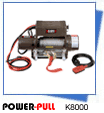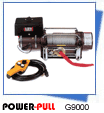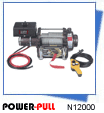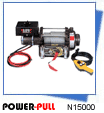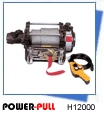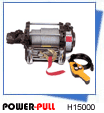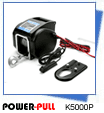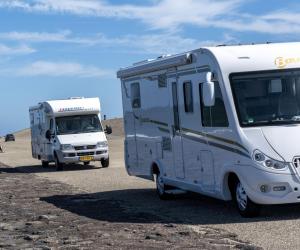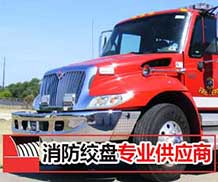WINCH TROUBLESHOOTING
CONDITION
POSSIBLE CAUSE
CORRECTION
MOTOR RUNS IN ONLY ONE DIRECTION
(1) Defective solenoid or stuck solenoid
(1) Jar solenoid to free contacts. Check by applying 12
volts to coil terminal (it should make an audible click when
energized)
(2) Defective remote control switch
(2) Disengage winch clutch, remove remote control switch plug from the socket and jump pins at 8 and 4 o’clock. Motor should run. Jump pins at 8 and 10 o’clock. Motor
should run.
MOTOR RUNS EXTREMELY HOT
(1) Long period of operation
(1) Cooling-off periods are essential to prevent overheating.
MOTOR RUNS, BUT WITH INSUFFICIENT POWER, OR WITH
LOW LINE SPEED
(1) Insufficient battery
(1) Check battery terminal voltage under load. If 10 volts or less, replace or parallel another battery to it.
(2) Bad connection
(2) Check battery cables for corrosion; clean and grease.
(3) Insufficient charging system
(3) Replace with larger capacity charging system.
MOTOR RUNS, BUT DRUM DOES NOT TURN
(1) Clutch not engaged
(1) If clutch engaged but symptom still exists, it will be
necessary to disassemble winch to determine cause and
repair.
MOTOR WILL NOT OPERATE
(1) Defective solenoid or stuck solenoid
(1) Jar solenoid to free contacts. Check solenoid by
applying 12 volts to coil terminal (it should make an
audible click when energized).
(2) Defective remote control switch
(2) Disengage winch clutch, remove remote control switch
plug from the socket and jump pins at 8 and 4 o’clock.
Motor should run. Jump pins at 8 and 10 o’clock. Motor
should run.
(3) Defective motor
(3) If solenoids operate, check for voltage at armature
post; replace motor.
(4) Loose connections
(4) Tighten connections on bottom side of hood and on
motor.
MOTOR WATER DAMAGED
(1) Submerged in water or water from
high pressure car wash
(1) Allow to drain and dry thoroughly, then run motor
without load in short bursts to dry windings.
CABLE DRUM WILL NOT FREESPOOL OR IS DIFFICULT TO FREESPOOL
(1) Clutch not disengaged
(1) Check clutch operation according to nameplate. Make
sure clutch shifter knob is fully at “OUT” position.
(2) Winch not mounted squarely causing end bearing to bind drum (model dependant)
(2) Check mounting to see that installation instructions have been followed.
Ring gear retainer capscrews are too tight. (model dependant)
(3) Remove the gear housing cover, 413018, and all gears
from inside the gear housing. Disengage the clutch and
check to see that the ring gear will rotate by hand. If it will
not, using a hex (allen) wrench, slightly loosen all the
capscrews and then snugly re-tighten them in criss-cross
pattern, but do not over-tighten. The ring gear must rotate by hand. Re-assemble winch.
MAINTENANCE
Inspect the wire rope before and after each winching operation. If the wire rope has become kinked or frayed, the wire rope needs to be replaced. Be sure to also inspect the winch hook and hook pin for signs of wear or damage. Replace if necessary.
Keep winch, wire rope, and switch control free from contaminants. Use a clean rag or towel to remove any dirt and debris. If necessary, unwind winch completely (leaving a minimum of 5 wraps on spooling drum), wipe clean, and rewind properly before storage. Using a light oil on the wire rope and winch hook can keep rust and corrosion from forming.
Operating your winch for a long period of time places an extra burden on your vehicle’s battery. Be sure to check and maintain your battery and battery cables according to manufacturer guidelines. Also inspect switch control and all electrical connections to be certain they are clean and tight fitting.
Inspect the remote control for damage, if so equipped. Be sure to cap the remote socket to prevent dirt and debris from entering the connections. Store remote control in a protected, clean, dry area.
Many winches require no lubrication for the life of the winch. However check with your manufacturer's instructional manual for specific maintenance and lubrication requirements.


